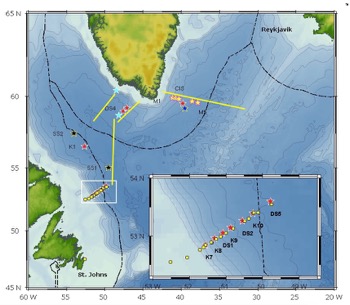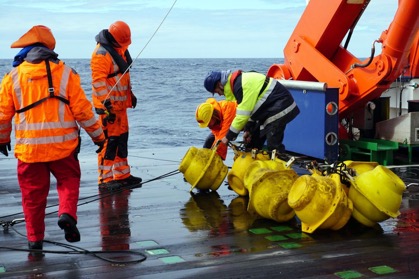By Nicolai Bronikowski
Blog Entry 2:
There are many fantastic people from all corners of the world on board of our cruise and in the next few entries I like to introduce some of these people I have the pleasure dealing with every day. One of our scientists, Penny Holliday is an ocean going oceanographer from NOC (National Oceanography Centre), who joined our cruise from Southampton, UK. Penny has worked in Ocean science for over two decades and leads the UK OSNAP program.
Penny told me what really got her interested in Oceanography was the possibility to work on so many projects and how connected everything about the ocean is. Penny herself calls her starting point in oceanography a coincidence. Penny was analysing a hydrographic time series when she noticed that her data set could not be explained without digging deeper into the wider Atlantic circulation. This was her starting point in studying the currents in the North Atlantic, which is the focus of the OSNAP program.
But why does this transport matter? It may not be obvious to think about the cold North Atlantic as an important driver of our pleasant weather in Europe. Penny told me that without the currents in the North Atlantic transporting water South-North which is called the Meridional Overturning Circulation, the weather in Europe would be much colder than it is now. Indeed, understanding the way this circulation changes and what drives it are in Penny’s view the key to adapting better to climate change.
I also asked Penny what she has most enjoyed about Oceanography and she admits it’s the travel and the opportunity to do lots of different things. To Penny one of the best things about oceanography are its interdisciplinary focus, with opportunity to work with lots of people. Penny is frequently on ships and her number one advice is to take the time to meet as many people as possible, make friends and be open to learn about topics that may not be directly related to your research focus.

Penny working on the mooring spool together with GEOMAR student Ilmar Leinmann (Photo credit: Penny Holliday)
On our cruise the last few days were filled with extracting and deploying moorings (K7-K10) and taking CTDs along the 53 North Array. The array stretches from the Newfoundland-Labrador shelf between depths of few hundreds to over 3000 meters deep. Most of the instruments we recover have been sampling for over two years and our task is to extract the data and ready them for the next mooring deployment with the OSNAP program. For us as young scientists we get to learn a lot of practical and technical skills changing batteries and calibrating the sensors and we feel the responsibility of doing a good job. After all the continued success of the program depends on new and accurate data.

